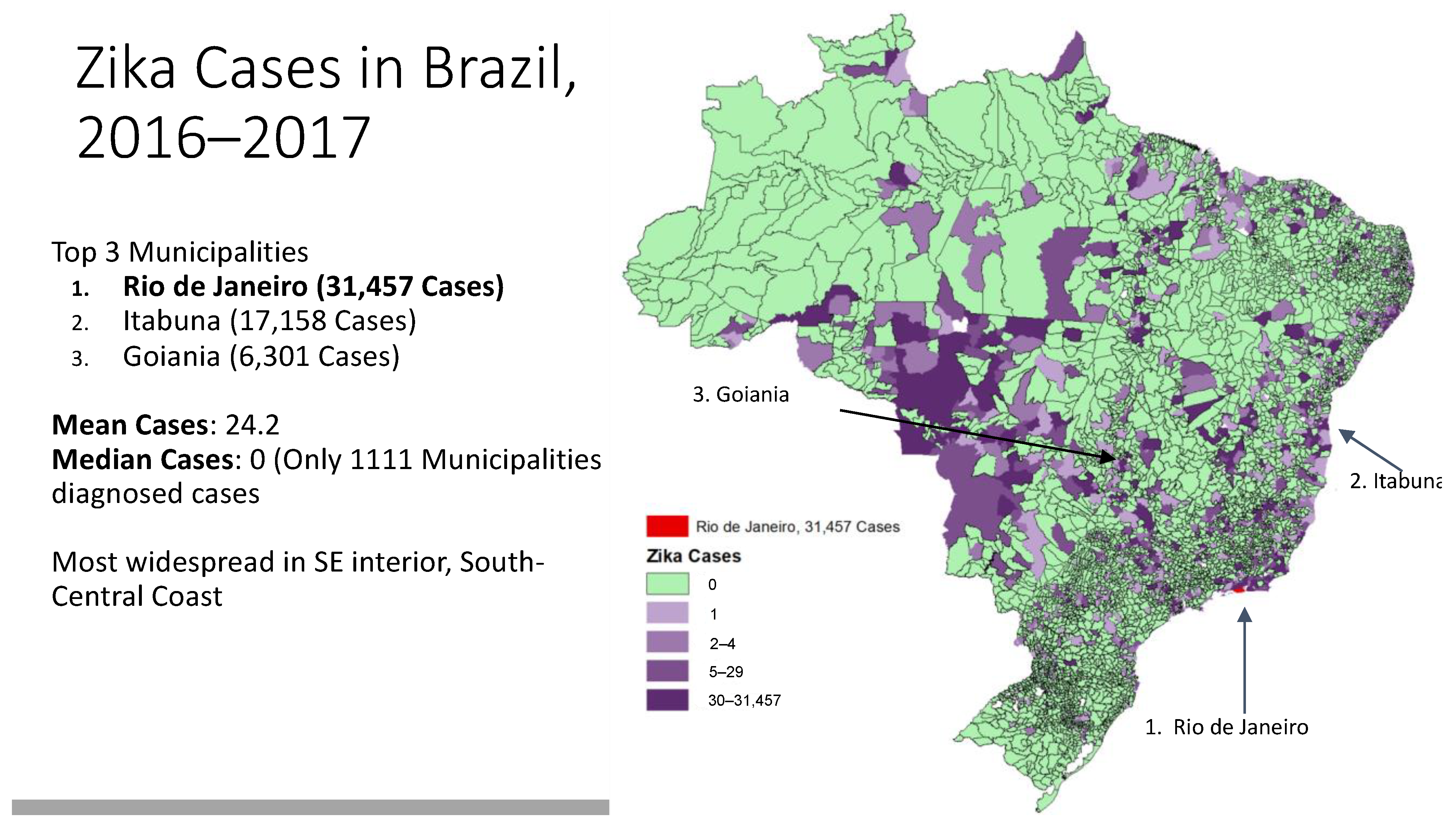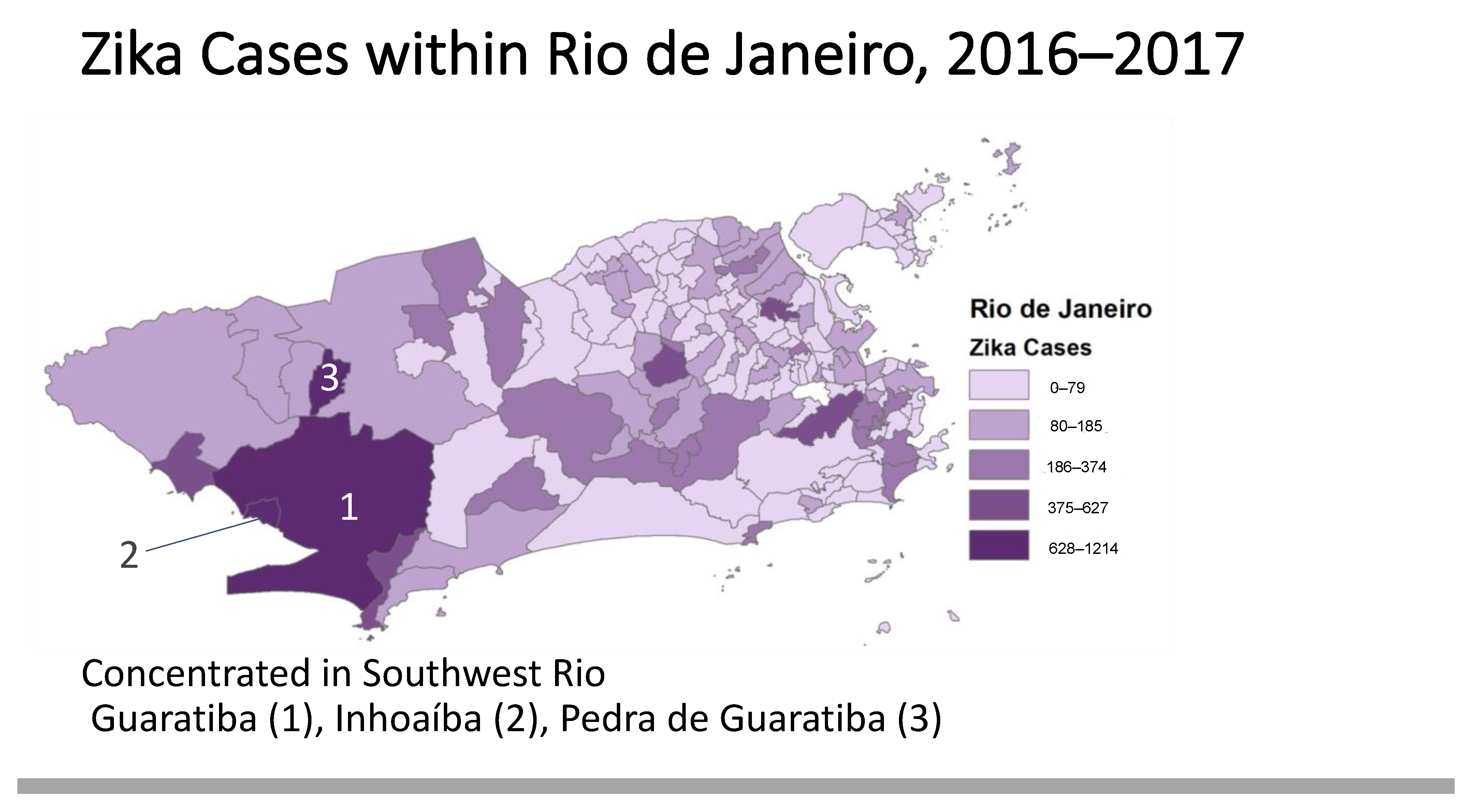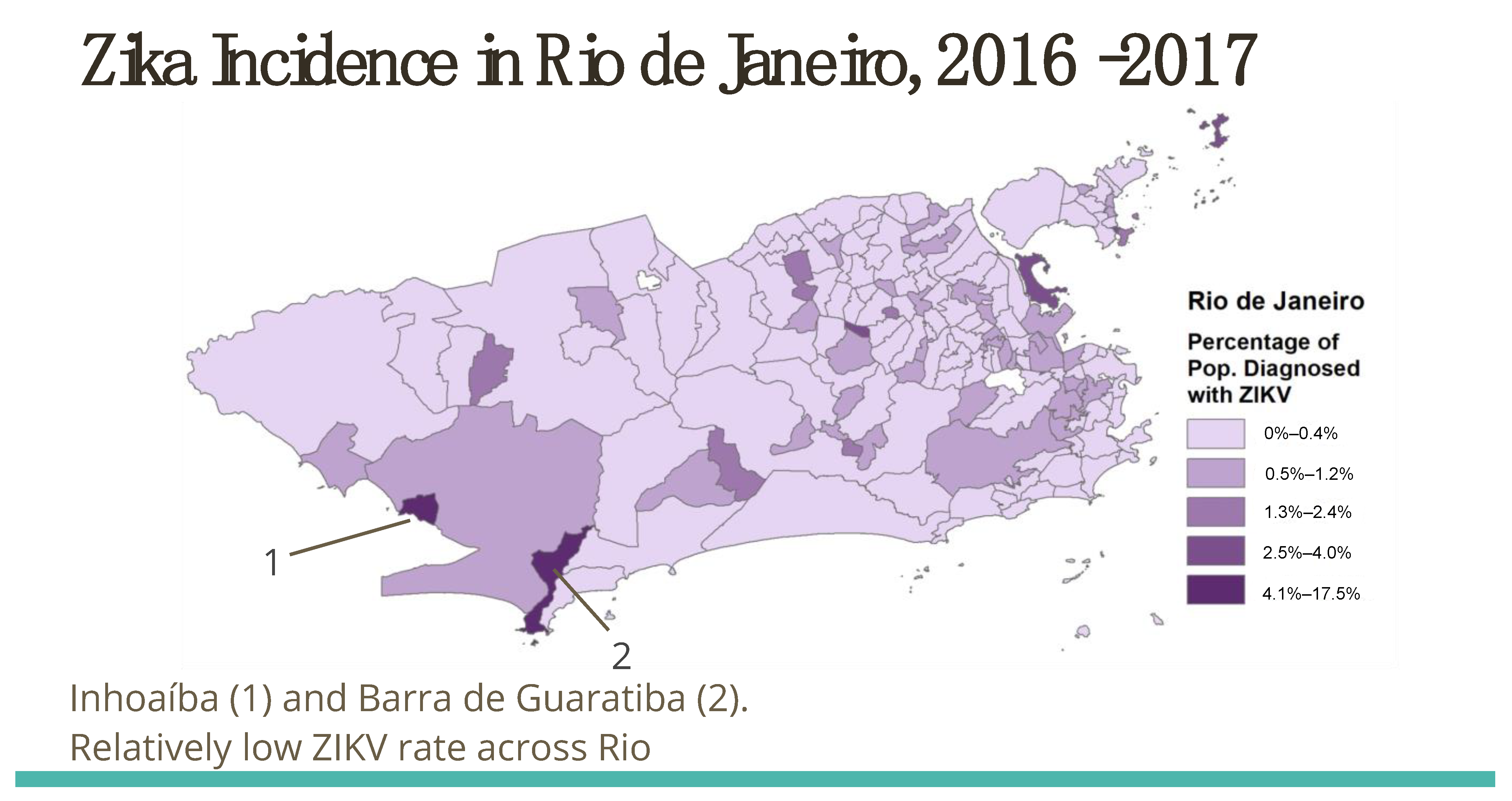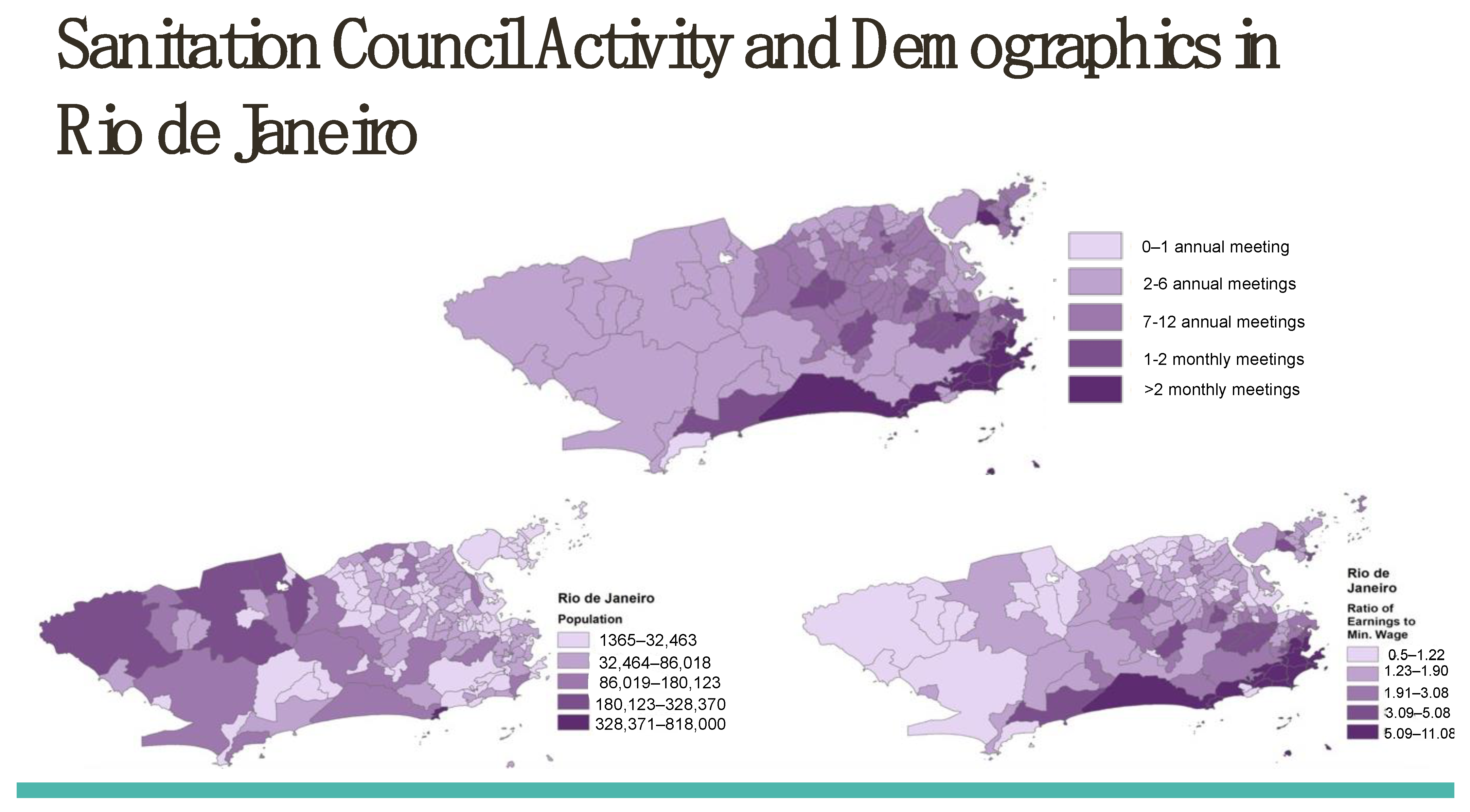Democratizing Public Health: Participatory Policymaking Institutions, Mosquito Control, and Zika in the Americas
Abstract
1. Introduction
2. Background
3. Brazil’s Zika Response
Can Extending Local Democracy Combat Zika?
4. Data and Methods
4.1. Family Health Program (PSF) Coverage
4.2. Local Administrative Capacity
4.3. Municipal Healthcare Spending
4.4. Left Mayor
4.5. Political Competition
4.6. Geography and Seasonality
5. Estimation Strategy
6. Results and Discussion
7. Limitations
8. Conclusions
Supplementary Materials
Author Contributions
Funding
Institutional Review Board Statement
Informed Consent Statement
Data Availability Statement
Conflicts of Interest
References
- Souza, M.P.A.; da Natividade, M.S.; Werneck, G.L.; Dos Santos, D.N. Congenital Zika syndrome and living conditions in the largest city of northeastern Brazil. BMC Public Health 2022, 22, 1231. [Google Scholar] [CrossRef]
- Branco, R.C.C.; Brasil, P.; Araújo, J.M.G.; Cardoso, F.O.; Batista, Z.S.; Leitão, V.M.S.; da Silva, M.A.C.N.; de Castro, L.O.; Valverde, J.G.; Jeronimo, S.M.B.; et al. Evidence of Zika virus circulation in asymptomatic pregnant women in Northeast, Brazil. PLoS Negl. Trop. Dis. 2021, 15, 94–112. [Google Scholar] [CrossRef]
- Charlesworth, S.M.; Kligerman, D.C.; Blackett, M.; Warwick, F. The Potential to Address Disease Vectors in Favelas in Brazil Using Sustainable Drainage Systems: Zika, Drainage and Greywater Management. Int. J. Environ. Res. Public Health 2022, 19, 2860–2873. [Google Scholar] [CrossRef] [PubMed]
- PAHO (Pan American Health Organization). Arbovirus Bulletin; Pan-American Health Organization: Washington, DC, USA, 2022; Available online: https://ais.paho.org/ha_viz/Arbo/Arbo_Bulletin_2022.asp?env=pri (accessed on 13 May 2022).
- Mugabe, V.A.; Borja, L.S.; Cardoso, C.W.; Weaver, S.C.; Reis, M.G.; Kitron, U.; Ribeiro, G.S. Changes in the dynamics of dengue incidence in South and Central America are possibly due to cross-population immunity after Zika virus epidemics. Trop. Med. Int. Health 2021, 26, 272–280. [Google Scholar] [CrossRef] [PubMed]
- Sittikul, P.; Sriburin, P.; Rattanamahaphoom, J.; Limkittikul, K.; Sirivichayakul, C.; Chatchen, S. Combining Immunoassays to Identify Zika Virus Infection in Dengue-Endemic Areas. Trop. Med. Infect. Dis. 2022, 7, 254–268. [Google Scholar] [CrossRef] [PubMed]
- Touchton, M.; Sugiyama, N.B.; Wampler, B. Democracy at work: Moving beyond elections to improve well-being. Am. Political Sci. Rev. 2017, 111, 68–82. [Google Scholar] [CrossRef]
- Wampler, B.; Sugiyama, N.B.; Touchton, M. Democracy at Work: Pathways to Well-Being in Brazil; Cambridge University Press: New York, NY, USA, 2019. [Google Scholar]
- Touchton, M.; Wampler, B.; Peixoto, T. Of democratic governance and revenue: Participatory institutions and tax generation in Brazil. Governance 2021, 34, 1193–1212. [Google Scholar] [CrossRef]
- Brazilian Ministry of Health. Zika Incidence in Brazil’s Municipalities; Government of Brazil: Brasilia, Brazil, 2019.
- Pepe, V.L.E.; Albuquerque, M.V.D.; Osorio-de-Castro, C.G.S.; Pereira, C.C.D.A.; Oliveira, C.V.D.S.; Reis, L.G.D.C.; Reis, C.D.B.; Dias, H.S.; Miranda, E.S. Proposal for integrated analysis of public health emergencies involving arboviruses: The case of the Zika virus in Brazil. Saúde Debate 2021, 44, 69–83. [Google Scholar] [CrossRef]
- Yakob, L. Zika Virus after the Public Health Emergency of International Concern Period, Brazil. Emerg. Infect. Dis. 2022, 28, 837–848. [Google Scholar] [CrossRef]
- Paixão, E.S.; Fernandes, Q.H.R.F.; Cardim, L.L.; Pescarini, J.M.; Costa, M.C.N.; Falcão, I.R.; Brickley, E.B.; Costa Santos, A.; Portela Souza, A.; Carvalho-Sauer, R.d.C.O.; et al. Socioeconomic risk markers of congenital Zika syndrome: A nationwide, registry-based study in Brazil. BMJ Glob. Health 2022, 7, 855–869. [Google Scholar] [CrossRef]
- Salmon, D.; Opel, D.J.; Dudley, M.Z.; Brewer, J.; Breiman, R. Reflections on Governance, Communication, And Equity: Challenges And Opportunities In COVID-19 Vaccination: Article examines the engagement and communication steps necessary to strengthen the COVID-19 vaccine roll out by federal, state, and local governments. Health Aff. 2021, 40, 419–425. [Google Scholar]
- Rocha, R.; Atun, R.; Massuda, A.; Rache, B.; Spinola, P.; Nunes, L.; Castro, M.C. Effect of socioeconomic inequalities and vulnerabilities on health-system preparedness and response to COVID-19 in Brazil: A comprehensive analysis. Lancet Glob. Health 2021, 9, 782–792. [Google Scholar] [CrossRef] [PubMed]
- Sen, A. Development as Freedom; Knopf: New York, NY, USA, 1999. [Google Scholar]
- Hone, T.; Rasella, D.; Barreto, M.; Atun, R.; Majeed, A.; Millett, C. Large reductions in amenable mortality associated with Brazil’s primary care expansion and strong health governance. Health Aff. 2017, 36, 149–158. [Google Scholar] [CrossRef]
- Costa-Font, J.; Parmar, D. Does local democracy improve public health interventions? Evidence from India. Governance 2022, 35, 799–825. [Google Scholar] [CrossRef]
- Wink, G.; Fransen, G.; Huisman, M.; Boersma, S.; Van Disseldorp, L.; van der Velden, K.; Wagemakers, A.; van den Muijsenbergh, M. ‘Improving Health through Reducing Stress’: Parents’ Priorities in the Participatory Development of a Multilevel Family Health Programme in a Low-Income Neighbourhood in The Netherlands. Int. J. Environ. Res. Public Health 2021, 18, 8145. [Google Scholar] [CrossRef] [PubMed]
- Moon, M.J. Fighting COVID-19 with agility, transparency, and participation: Wicked policy problems and new governance challenges. Public Adm. Rev. 2020, 80, 651–656. [Google Scholar] [CrossRef]
- de Aguiar Pereira, C.C.; de Goes Cavalcanti, L.P.; Hofer, C.B.; de Barros Reis, C. Out-of-Pocket expenditures associated with Congenital Zika Syndrome in Brazil: An analysis of household health spending. medRxiv 2021. [Google Scholar] [CrossRef]
- Albuquerque, M.S.; Lyra, T.M.; Melo, A.P.; Valongueiro, S.A.; Araújo, T.V.; Pimentel, C.; Penn-Kekana, L. Access to healthcare for children with Congenital Zika Syndrome in Brazil: Perspectives of mothers and health professionals. Health Policy Plan. 2019, 34, 499–507. [Google Scholar] [CrossRef]
- Mayka, L. Building Participatory Institutions in Latin America: Reform Coalitions and Institutional Change; Cambridge University Press: New York, NY, USA, 2019. [Google Scholar]
- Rich, J. State-Sponsored Activism: Bureaucrats and Social Movements in Democratic Brazil; Cambridge University Press: New York, NY, USA, 2019. [Google Scholar]
- Wampler, B.; Touchton, M. Designing institutions to improve well-being: Participation, deliberation and institutionalisation. Eur. J. Political Res. 2019, 58, 915–937. [Google Scholar] [CrossRef]
- Araujo, A.Q.; Silva, M.T.T.; Araujo, A.P. Zika virus-associated neurological disorders: A review. Brain 2016, 139, 2122–2130. [Google Scholar] [CrossRef]
- da Silva, I.R.F.; Frontera, J.A.; de Filippis, A.M.B.; Do Nascimento, O.J.M. Neurologic complications associated with the Zika virus in Brazilian adults. JAMA Neurol. 2017, 74, 1190–1198. [Google Scholar] [CrossRef]
- Ximenes, R.A.D.A.; Miranda-Filho, D.D.B.; Montarroyos, U.R.; Martelli, C.M.T.; Araújo, T.V.B.D.; Brickley, E. Microcephaly Epidemic Research Group (MERG). Zika-related adverse outcomes in a cohort of pregnant women with rash in Pernambuco, Brazil. PLoS Negl. Trop. Dis. 2021, 15, 123–131. [Google Scholar] [CrossRef] [PubMed]
- Yadav, A.R.; Mohite, S.K. A review on zika virus infection. Res. J. Pharm. Dos. Technol. 2020, 12, 295–297. [Google Scholar] [CrossRef]
- Silvério, M.R.S.; Espindola, L.S.; Lopes, N.P.; Vieira, P.C. Plant natural products for the control of Aedes aegypti: The main vector of important arboviruses. Molecules 2020, 25, 3484. [Google Scholar] [CrossRef]
- Brady, O.J.; Hay, S.I. The global expansion of dengue: How Aedes aegypti mosquitoes enabled the first pandemic arbovirus. Annu. Rev. Entomol. 2020, 65, 191–208. [Google Scholar] [CrossRef]
- Taslem Mourosi, J.; Awe, A.; Jain, S.; Batra, H. Nucleic Acid Vaccine Platform for DENGUE and ZIKA Flaviviruses. Vaccines 2022, 10, 834. [Google Scholar] [CrossRef]
- World Health Organization. Zika Virus Outbreak Global Response: Interim Report; (No. WHO/ZIKV/SRF/16.2); World Health Organization: Geneva, Switzerland, 2016.
- Relich, R.F.; Loeffelholz, M. Zika Virus. Clin. Lab. Med. 2017, 37, 253–267. [Google Scholar] [CrossRef]
- Puntasecca, C.J.; King, C.H.; LaBeaud, A.D. Measuring the global burden of chikungunya and Zika viruses: A systematic review. PLoS Negl. Trop. Dis. 2021, 15, 955–971. [Google Scholar] [CrossRef]
- Rodrigues, R.R.N.; Grisotti, M. Communicating on Zika: Prevention recommendations in contexts of uncertainties. Interface-Comun. Saúde Educ. 2019, 23, 214–222. [Google Scholar]
- Cruvinel, V.R.N.; Zolnikov, T.R.; Obara, M.T.; de Oliveira, V.T.L.; Vianna, E.N.; do Santos, F.S.G.; Scott, J.A. Vector-borne diseases in waste pickers in Brasilia, Brazil. Waste Manag. 2020, 105, 223–232. [Google Scholar] [CrossRef] [PubMed]
- Bancroft, D.; Power, G.M.; Jones, R.T.; Massad, E.; Iriat, J.B.; Preet, R.; Logan, J.G. Vector control strategies in Brazil: A qualitative investigation into community knowledge, attitudes and perceptions following the 2015–2016 Zika virus epidemic. BMJ Open 2022, 12, 50–63. [Google Scholar] [CrossRef] [PubMed]
- Périssé, A.R.S.; Souza-Santos, R.; Duarte, R.; Santos, F.; de Andrade, C.R.; Rodrigues, N.C.P.; Schramm, J.M.d.A.; ds Silva, E.D.; Jacobson, L.d.S.V.; Lemos, M.C.F.; et al. Zika, dengue and chikungunya population prevalence in Rio de Janeiro city, Brazil, and the importance of seroprevalence studies to estimate the real number of infected individuals. PLoS ONE 2020, 15, 2432–2439. [Google Scholar] [CrossRef]
- He, D.; Zhao, S.; Lin, Q.; Musa, S.S.; Stone, L. New estimates of the Zika virus epidemic attack rate in Northeastern Brazil from 2015 to 2016: A modelling analysis based on Guillain-Barré Syndrome (GBS) surveillance data. PLoS Negl. Trop. Dis. 2020, 14, 75–83. [Google Scholar] [CrossRef] [PubMed]
- Brito, A.F.; Machado, L.C.; Oidtman, R.J.; Siconelli, M.J.L.; Tran, Q.M.; Fauver, J.R.; Grubaugh, N.D. Lying in wait: The resurgence of dengue virus after the Zika epidemic in Brazil. Nat. Commun. 2021, 12, 2619. [Google Scholar] [CrossRef]
- Epelboin, S.; Dulioust, E.; Epelboin, L.; Benachi, A.; Merlet, F.; Patrat, C. Zika virus and reproduction: Facts, questions and current management. Hum. Reprod. Update 2017, 23, 629–645. [Google Scholar] [CrossRef] [PubMed]
- Faria, N.R.; da Silva Azevedo, R.D.S.; Kraemer, M.U.; Souza, R.; Cunha, M.S.; Hill, S.C.; Rocco, I.M. Zika virus in the Americas: Early epidemiological and genetic findings. Science 2016, 352, 345–349. [Google Scholar] [CrossRef] [PubMed]
- dos Santos Costa, A.C.; Hasan, M.M.; Xenophontos, E.; Mohanan, P.; Bassey, E.E.; Hashim, H.T.; Essar, M.Y. COVID-19 and Zika: An emerging dilemma for Brazil. J. Med. Virol. 2021, 93, 4124–4138. [Google Scholar] [CrossRef]
- Shirley, D.T.; Nataro, J.P. Zika virus infection. Pediatr. Clin. N. Am. 2017, 64, 937–951. [Google Scholar] [CrossRef]
- Borges, B.; Pereira, M.; Oliveira, M.; Thiago, A.; Touchton, M. Dengue Behavior in The Face of the COVID-19 Pandemic in Minas Gerais, Brazil. Public Health Open Access 2020, 6, 000206. [Google Scholar]
- Gómez, E.J.; Perez, F.A.; Ventura, D. What explains the lackluster response to Zika in Brazil? Exploring institutional, economic and health system context. BMJ Glob. Health 2018, 3, 862–875. [Google Scholar] [CrossRef]
- de Souza, R.A.; Nery, J.S.; Rasella, D.; Guimarães Pereira, R.A.; Barreto, M.L.; Rodrigues, L.; Pereira, S.M. Family health and conditional cash transfer in Brazil and its effect on tuberculosis mortality. Int. J. Tuberc. Lung Dis. 2018, 22, 1300–1306. [Google Scholar] [CrossRef]
- Castro, M.C. Zika virus and health systems in Brazil: From unknown to a menace. Health Syst. Reform 2016, 2, 119–122. [Google Scholar] [CrossRef] [PubMed][Green Version]
- Matta, G.C.; de Oliveira Nogueira, C.; da Silva Nascimento, L. A Literary History of Zika: Following Brazilian State Responses through Documents of Emergency; Routledge: New York, NY, USA, 2019. [Google Scholar]
- Venancio de Siqueira, S.; Lobato, L.; Vaitsman, J.; Hollanda, E.; Nóbrega, I. The Implementation of Intersectoral Actions of Health and Social Assistance to Assist Children with Congenital Zika Syndrome in the State of Rio de Janeiro; Institute for Development Studies: Sussex, UK, 2019. [Google Scholar]
- Ambrogi, I.G.; Brito, L.; Diniz, D. The vulnerabilities of lives: Zika, women and children in Alagoas State, Brazil. Cad. Saúde Pública 2021, 36, 25–47. [Google Scholar] [CrossRef] [PubMed]
- Snyder, R.E.; Boone, C.E.; Cardoso, C.A.A.; Aguiar-Alves, F.; Neves, F.P.; Riley, L.W. Zika: A scourge in urban slums. PLoS Negl. Trop. Dis. 2017, 11, 142–152. [Google Scholar] [CrossRef]
- Diniz, D. Zika virus and women. Cad. Saúde Pública 2016, 32, 46–63. [Google Scholar]
- Tambo, E.; Chuisseu, P.D.; Ngogang, J.Y.; Khater, E.I. Deciphering emerging Zika and dengue viral epidemics: Implications for global maternal–child health burden. J. Infect. Public Health 2016, 9, 240–250. [Google Scholar] [CrossRef] [PubMed]
- Lesser, J.; Kitron, U. The Social Geography of Zika in Brazil: Brazil’s Zika epidemic has placed new and added pressure on Brazil’s public health system, but much about the outbreak is very old. NACLA Rep. Am. 2016, 48, 123–129. [Google Scholar] [CrossRef]
- Lowe, R.; Barcellos, C.; Brasil, P.; Cruz, O.; Honório, N.; Kuper, H.; Carvalho, M. The Zika virus epidemic in Brazil: From discovery to future implications. Int. J. Environ. Res. Public Health 2018, 15, 96. [Google Scholar] [CrossRef]
- Touchton, M.; Brian, W. Improving Social Well-Being Through New Democratic Institutions. Comp. Political Stud. 2014, 47, 1442–1469. [Google Scholar] [CrossRef]
- Sugiyama, N.B. Diffusion of Good Government: Social Sector Reforms in Brazil; University of Notre Dame Press: South Bend, IN, USA, 2012. [Google Scholar]
- Cornwall, A.; Coelho, V.S. Spaces for Change? Zed Books: New York, NY, USA, 2007. [Google Scholar]
- Lavalle, G.; Voigt, A.J.; Serafim, L. Afinal o que Fazem os Conselhos: Padroes Decisorios e o Debate dos Efeitos das Instituico es Participativas. Dados 2018, 35, 107–120. [Google Scholar]
- Roberto, P. Efetividade das Instituiçãoes Participativas No Brasil; Government of Brazil, IPEA: Brasilia, Brazil, 2011.
- Teixeira, M.G.; da Conceição, N.; Costa, M.; de Oliveira, W.K.; Nunes, M.L.; Rodrigues, L.C. The epidemic of Zika virus–related microcephaly in Brazil: Detection, control, etiology, and future scenarios. Am. J. Public Health 2016, 106, 601–605. [Google Scholar] [CrossRef] [PubMed]
- Heukelbach, J.; Werneck, G.L. Surveillance of Zika virus infection and microcephaly in Brazil. Lancet 2016, 388, 846–847. [Google Scholar] [CrossRef] [PubMed]
- R Core Team. R: A Language and Environment for Statistical Computing; R Foundation for Statistical Computing: Vienna, Austria, 2022; Available online: https://www.R-project.org/ (accessed on 13 May 2022).
- ArcGIS. ArcGIS Pro (Version 2.5). Esri Inc. 2022. Available online: https://www.esri.com/en-us/arcgis/products/arcgis-pro/overview (accessed on 13 May 2022).
- Brazilian Institute of Geography and Statistics. MUNIC Survey; Government of Brazil: Brasilia, Brazil, 2019.
- McGuire, J.W. Wealth, Health, and Democracy in East Asia and Latin America; Cambridge University Press: New York, NY, USA, 2010. [Google Scholar]
- Iacus, S.; King, G.; Porro, G. A theory of statistical inference for matching methods in causal research. Political Anal. 2019, 27, 46–68. [Google Scholar] [CrossRef]
- Ho, D.; Imai, K.; King, G.; Stuart, E.; Whitworth, A. Package ‘MatchIt’. Version 9.2. 2018. Available online: https://cran.r-project.org/web/packages/MatchIt/index.html (accessed on 19 September 2022).
- Hilbe, J. Negative Binomial Regression; Cambridge University Press: Cambridge, UK, 2007. [Google Scholar]
- Raymundo, C.E.; de Andrade Medronho, R. Association between socio-environmental factors, coverage by family health teams, and rainfall in the spatial distribution of Zika virus infection in the city of Rio de Janeiro, Brazil, in 2015 and 2016. BMC Public Health 2021, 21, 1199. [Google Scholar] [CrossRef]
- Nunes, J. The everyday political economy of health: Community health workers and the response to the 2015 Zika outbreak in Brazil. Rev. Int. Political Econ. 2020, 27, 146–166. [Google Scholar] [CrossRef]
- Suparit, P.; Wiratsudakul, A.; Modchang, C. A mathematical model for Zika virus transmission dynamics with a time-dependent mosquito biting rate. Theor. Biol. Med. Model. 2018, 15, 11. [Google Scholar] [CrossRef]
- Martínez-Bello, D.A.; López-Quílez, A.; Torres Prieto, A. Spatio-temporal modeling of Zika and dengue infections within Colombia. Int. J. Environ. Res. Public Health 2018, 15, 1376. [Google Scholar] [CrossRef]
- Pescarini, J.M.; Rodrigues, M.; Paixão, E.S.; Cardim, L.; Brito, C.A.D.; Costa, M.D.C.N.; Brickley, E.B. Dengue, Zika, and Chikungunya viral circulation and hospitalization rates in Brazil from 2014 to 2019: An ecological study. PLoS Negl. Trop. Dis. 2022, 16, 106–115. [Google Scholar] [CrossRef] [PubMed]
- Costa, L.C.; Veiga, R.V.; Oliveira, J.F.; Rodrigues, M.S.; Andrade, R.F.; Paixão, E.S.; Gräf, T. New insights on the Zika virus arrival in the Americas and spatiotemporal reconstruction of the epidemic dynamics in Brazil. Viruses 2020, 13, 12. [Google Scholar] [CrossRef] [PubMed]
- Rosado, L.E.P.; Aquino, E.C.D.; Brickley, E.B.; França, D.D.D.S.; Silva, F.P.A.; Silva, V.L.D.; Turchi, M.D. Socioeconomic disparities associated with symptomatic Zika virus infections in pregnancy and congenital microcephaly: A spatiotemporal analysis from Goiânia, Brazil (2016 to 2020). PLoS Negl. Trop. Dis. 2022, 16, 566–578. [Google Scholar] [CrossRef]
- Kazazian, L.; Lima Neto, A.S.; Sousa, G.S.; Nascimento, O.J.D.; Castro, M.C. Spatiotemporal transmission dynamics of co-circulating dengue, Zika, and chikungunya viruses in Fortaleza, Brazil: 2011–2017. PLoS Negl. Trop. Dis. 2020, 14, 87–95. [Google Scholar] [CrossRef] [PubMed]
- McHale, T.C.; Romero-Vivas, C.M.; Fronterre, C.; Arango-Padilla, P.; Waterlow, N.R.; Nix, C.D.; Cano, J. Spatiotemporal heterogeneity in the distribution of chikungunya and Zika virus case incidences during their 2014 to 2016 epidemics in Barranquilla, Colombia. Int. J. Environ. Res. Public Health 2019, 16, 1759. [Google Scholar] [CrossRef] [PubMed]




| Municipal Zika Cases per 100,000 Residents | |||
|---|---|---|---|
| Predictors | Estimates | CI | p |
| (Intercept) | 38.92 | 28.38–49.46 | <0.01 |
| Environmental Sanitation Council | −5.21 | −4.68–−5.74 | <0.01 |
| FHP Coverage | −0.28 | −0.14–−0.42 | 0.04 |
| Local State Capacity | −0.18 | −0.06–−0.33 | 0.17 |
| Mayoral Vote Share | −0.27 | 0.24–−76 | 0.34 |
| Left Mayor | 0.35 | 0.10–0.53 | 0.23 |
| Health Spending (per capita, logged) | −0.53 | 0.26–0.71 | <0.01 |
| Observations | 5382 | ||
| Wald Chi2 (6) | 239.42 | ||
| Prob > Chi2 | 0.00 | ||
| R2 | 0.34 | ||
| Municipal Zika Cases per 100,000 Residents | |||
|---|---|---|---|
| Predictors | Estimates | CI | p |
| (Intercept) | 40.10 | 27.94–51.38 | <0.01 |
| Environmental Sanitation Council | −5.04 | −4.39–−5.61 | <0.01 |
| FHP Coverage | −0.31 | −0.20–−0.39 | 0.02 |
| Local State Capacity | −0.20 | −0.09–−0.31 | 0.04 |
| Mayoral Vote Share | −0.16 | 0.32–−86 | 0.43 |
| Left Mayor | 0.22 | 0.03–0.64 | 0.15 |
| Health Spending (per capita, logged) | −0.29 | −0.13–−0.44 | <0.01 |
| Observations | 5264 | ||
| Wald Chi2 (6) | 251.37 | ||
| Prob > Chi2 | 0.00 | ||
| R2 | 0.29 | ||
| Municipal Zika Cases per 100,000 Residents | |||
|---|---|---|---|
| Predictors | Estimates | CI | p |
| (Intercept) | 39.04 | 27.83–49.26 | <0.01 |
| Time with Environmental Sanitation Council | −1.57 | −1.03–−2.11 | <0.01 |
| FHP Coverage | −0.16 | 0.05–−0.31 | 0.14 |
| Local State Capacity | −0.09 | 0.10–−0.26 | 0.21 |
| Mayoral Vote Share | −0.21 | 0.25–−66 | 0.38 |
| Left Mayor | 0.27 | 0.07–0.43 | 0.15 |
| Health Spending (per capita, logged) | −0.45 | −0.17–−0.62 | <0.01 |
| Observations | 4959 | ||
| Wald Chi2 (6) | 220.67 | ||
| Prob > Chi2 | 0.00 | ||
| R2 | 0.37 | ||
| Municipal Zika Cases per 100,000 Residents | |||
|---|---|---|---|
| Predictors | Estimates | CI | p |
| (Intercept) | 41.23 | 24.27–56.35 | <0.01 |
| Time with Environmental Sanitation Council | −1.29 | −1.05–−1.42 | <0.01 |
| FHP Coverage | −0.25 | 0.09–−0.46 | 0.24 |
| Local State Capacity | −0.11 | 0.06–−0.23 | 0.16 |
| Mayoral Vote Share | −0.20 | 0.29–−65 | 0.33 |
| Left Mayor | 0.24 | −0.08–0.46 | 0.09 |
| Health Spending (per capita, logged) | −0.17 | −0.06–−0.27 | <0.01 |
| Observations | 4955 | ||
| Wald Chi2 (6) | 228.70 | ||
| Prob > Chi2 | 0.00 | ||
| R2 | 0.31 | ||
Disclaimer/Publisher’s Note: The statements, opinions and data contained in all publications are solely those of the individual author(s) and contributor(s) and not of MDPI and/or the editor(s). MDPI and/or the editor(s) disclaim responsibility for any injury to people or property resulting from any ideas, methods, instructions or products referred to in the content. |
© 2023 by the authors. Licensee MDPI, Basel, Switzerland. This article is an open access article distributed under the terms and conditions of the Creative Commons Attribution (CC BY) license (https://creativecommons.org/licenses/by/4.0/).
Share and Cite
Touchton, M.; Wampler, B. Democratizing Public Health: Participatory Policymaking Institutions, Mosquito Control, and Zika in the Americas. Trop. Med. Infect. Dis. 2023, 8, 38. https://doi.org/10.3390/tropicalmed8010038
Touchton M, Wampler B. Democratizing Public Health: Participatory Policymaking Institutions, Mosquito Control, and Zika in the Americas. Tropical Medicine and Infectious Disease. 2023; 8(1):38. https://doi.org/10.3390/tropicalmed8010038
Chicago/Turabian StyleTouchton, Michael, and Brian Wampler. 2023. "Democratizing Public Health: Participatory Policymaking Institutions, Mosquito Control, and Zika in the Americas" Tropical Medicine and Infectious Disease 8, no. 1: 38. https://doi.org/10.3390/tropicalmed8010038
APA StyleTouchton, M., & Wampler, B. (2023). Democratizing Public Health: Participatory Policymaking Institutions, Mosquito Control, and Zika in the Americas. Tropical Medicine and Infectious Disease, 8(1), 38. https://doi.org/10.3390/tropicalmed8010038






